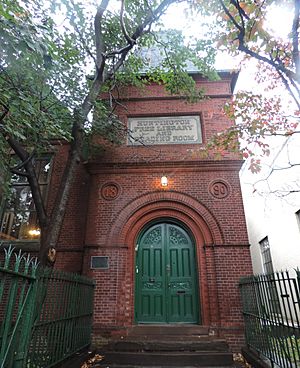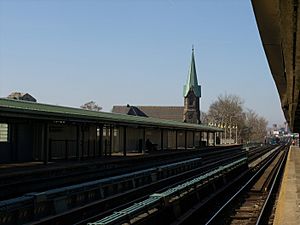Westchester Square, Bronx facts for kids
Quick facts for kids
Westchester Square
|
|
|---|---|
|
Neighborhood of the Bronx
|
|

The front door to the historic Huntington Free Library on Lane Avenue
|
|
| Country | |
| State | |
| City | |
| Borough | |
| Community District | Bronx 10 |
| Economics | |
| ZIP Codes |
10461, 10462
|
| Area code | 718, 347, 929, and 917 |
Westchester Square is a residential neighborhood geographically located in the eastern section of the New York City borough of the Bronx. Its boundaries, starting from the north and moving clockwise are: East Tremont Avenue and Silver Street, Blondell Avenue and Westchester Creek to the east, Waterbury Avenue to the south and Castle Hill Avenue to the west. The main roadways through Westchester Square are East Tremont Avenue, Westchester Avenue and Williamsbridge Road.
The neighborhood is part of Bronx Community District 10, and its ZIP Codes include 10461 and 10462. The area is patrolled by the 45th Precinct of the New York City Police Department.
History
The village was founded about 1654 by English settlers who left New Haven Colony for Dutch New Netherland, on land purchased by Thomas Pell in 1654 from the sachem Ann-hock, alias Wampage, and other Native Americans, although his right to do so was disputed by the Dutch who also laid claim to the land. The settlers followed the Westchester Creek to a path behind what is now Herbert H. Lehman High School to where the Square is now. The settlement was called Oostdorp, or East Towne, and called Westchester by the English settlers.
In a war in 1655 between the Dutch and Native Americans, the settlers of Oostdorp where suspected by the Dutch of working with the Esopus and Wappinger Indians and being instigators, so as to drive the Dutch from the area. In addition, they were in communication with the New Haven Colony, which drove Peter Stuyvesant to order their removal and the destruction of their homes in March 1656. Twenty-three men were placed on board the ship de Waagh (the Scales) and taken to New Amsterdam, where they were held prisoner on the ship Ballance and "fed with rotten provision, creeping with worms, whereby some of them remained diseased to this day, after which they were carried away in chaines and laid in their dungeon at Manhatoes." Shortly afterwards, the settlers agreed to submit to Dutch law and authority and were permitted to remain at Westchester. Thomas Wheeler, Thomas Newman, and John Lord were selected as the first magistrates. At that time, the town consisted of 25 men and 10-12 women.
The village was the town seat of the Town of Westchester (the town hall being located at 40°50'33.91"N73°50'39.68"W) until 1895, when that town became part of greater New York City. The Square is still laid out like a village, with the Owen Dolen Plaza, previously the village green, once again a central feature of the community. It maintained a rural and small town atmosphere until 1920, when the Lexington Avenue IRT elevated line extended to Westchester Square, although there are still many 19th Century homes throughout the neighborhood, including several old Victorian mansions. The Huntington Free Library and Reading Room is a time capsule of 19th Century Westchester Square history, and is largely unchanged from its opening in the 1890s. From an economic standpoint, the Westchester Square B.I.D. (Business Improvement District) was formally signed into law in March 2012. Headed up by business owner John Bonizio, the B.I.D. which is funded by landlords and shopkeepers who pay a special property tax assessment to the city, helps to patrol and promote the immediate shopping corridor.
Arts and culture
- The Bronx Academy of Arts and Dance is located on the grounds of St. Peter's Episcopal Church in Westchester Square.
Parks and recreation
- Owen Dolen Park is bordered by Westchester Avenue, Lane Avenue and Williamsbridge Road. It was recently renovated and rededicated in June 2013. The $4.72 million renovation of the park was started in September 2011. It was named after Owen Dolen a lifelong community resident and teacher, in 1926. Dolen had died of a heart attack a year earlier after giving a speech at the Square to unveil a granite memorial honoring neighborhood soldiers killed in World War I.
- The name for the Pearly Gates Playground is derived from Christian tradition of the entranceway through which souls enter Heaven after death. The pearly gates are said to be guarded by Saint Peter, one of the founders of the Christian Church. The playground is named the Pearly Gates, because of its location on St. Peter’s Avenue. The playground originally opened in 1952 under the joint operation of Parks and the Board of Education. The park was originally called the Westchester Playground until 1998, when Parks Commissioner Henry Stern renamed the site The Pearly Gates.
Transportation
The following New York City Subway stations serve Westchester Square:
- East Tremont Avenue (6 <6> trains)
- Zerega Avenue (6 <6> trains)
The following MTA Regional Bus Operations bus routes serve Westchester Square:
- Bx4/Bx4A: to Third Avenue–149th Street (via Westchester Avenue; Bx4A also via East Tremont and Metropolitan Avenues)
- Bx8: to Williamsbridge or Locust Point (via Williamsbridge Road)
- Bx21: to Third Avenue–138th Street (via Morris Park Avenue)
- Bx24: to Country Club or Hutchinson Metro Center
- Bx31: to Woodlawn (via Eastchester Road)
- Bx40/Bx42: to Throggs Neck or Morris Heights (via Tremont Avenue)
Demographics
For census purposes, the New York City government classifies Westchester Square as part of a larger neighborhood tabulation area called Van Nest/Morris Park/Westchester Square. Based on data from the 2010 United States Census, the population of Van Nest/Morris Park/Westchester Square was 29,250, a change of 2,115 (7.2%) from the 27,135 counted in 2000. Covering an area of 829.61 acres (335.73 ha), the neighborhood had a population density of 35.3 inhabitants per acre (22,600/sq mi; 8,700/km2). The racial makeup of the neighborhood was 27.3% (7,987) White, 11.1% (3,245) African American, 0.3% (82) Native American, 10.6% (3,100) Asian, 0.1% (15) Pacific Islander, 1% (292) from other races, and 1.4% (410) from two or more races. Hispanic or Latino of any race were 48.3% (14,119) of the population.


